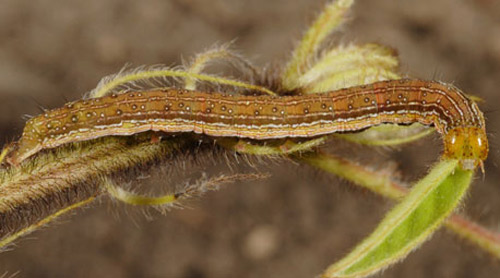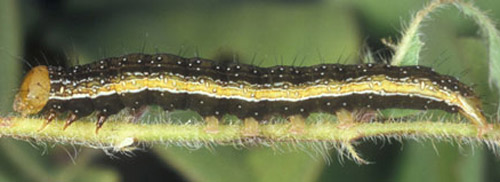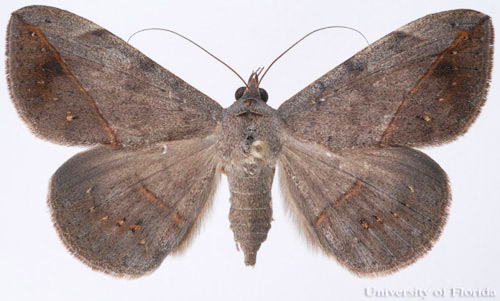common name: velvetbean caterpillar
scientific name: Anticarsia gemmatalis (Hübner) (Insecta: Lepidoptera: Noctuidae)
Introduction - Distribution - Life Cycle and Description - Host Plants - Damage - Natural Enemies - Management - Selected References
Introduction (Back to Top)
The velvetbean caterpillar, Anticarsia gemmatalis (Hübner), is the most damaging foliage feeding pest of soybean in Florida and the southeastern U.S. Infestations of the caterpillar occur in the late summer months and can cause great damage to soybean and other legume crops if not managed. The caterpillar is able to strip fields of soybean foliage in five to seven days (Wilkerson et al. 1986). Management of the velvetbean caterpillar can be achieved through use of natural enemies, insecticides and various cultural practices.
Figure 1. Adult velvetbean caterpillar, Anticarsia gemmatalis (Hübner), with folded wings. Photograph by Lyle J. Buss, University of Florida.
Figure 2. Last instar of a velvetbean caterpillar, Anticarsia gemmatalis (Hübner). Photograph by Lyle J. Buss, University of Florida.
Distribution (Back to Top)
The velvetbean caterpillar is native to the tropical and subtropical areas of the Western Hemisphere and was first found in Florida in 1903 (Hinds and Osterberger 1931). The velvetbean caterpillar is a permanent inhabitant of tropical America and migrates northward into the southeastern United States every year. The caterpillar overwinters in the southern tip of Florida and moves north during the summer months. Anticarsia gemmatalis is an annual problem from June through September in Florida, Georgia and Alabama. Infestations of velvetbean caterpillar are less severe in the western United States.
Life Cycle and Description (Back to Top)
Velvetbean caterpillars are active and will spring from plants and wiggle rapidly when disturbed. Individuals less than one-half inch long "loop" when they crawl and are often misidentified as soybean loopers (Sprenkel 1999). The life cycle of the velvetbean caterpillar is completed in about four weeks during the summer, but takes longer in the fall. The number of generations occurring depends on the dispersal and arrival of adults. Velvetbean caterpillar moths overwinter in southern Florida and begin moving northward in early summer. They arrive in north Florida by mid-August and are very abundant by September.
Egg: The egg of the velvetbean caterpillar is prominently ribbed, slightly oval, and white until just before hatching, when it turns pink. The egg is 1 mm to 2 mm in diameter, and flattened on the lower surface. Eggs are laid singly on the undersides of leaves, although in heavy infestations eggs may be found on the upper surfaces of leaves, on the petioles and even on the stems (Watson 1916). The egg stage usually lasts about three days when laid in August and September but requires a week or more when laid later in the fall.
Larvae: Newly hatched larvae feed on the shell of the egg they emerge from, leaving only the portion attached to the leaf. There are usually six instars of the velvetbean caterpillar. The larvae are extremely variable in coloration and markings throughout the instars. The majority have prominent dark longitudinal lines and narrow lines of white, yellow or pink. The larvae spend about two days in the first instar and grow from 2.5 mm to 6 or 7 mm before molting. The head is light brown, rounded and bilobed. The body of the first instar velvetbean caterpillar is a uniform light green without any longitudinal stripes. The prolegs on abdominal segments 3 and 4 are smaller than those on segments 5 and 6.
In the second instar, the black border to the lateral line appears and the first pair of abdominal prolegs is about one-fourth as long as the third pair. The second pair of prolegs is one-half as long as the third. The second, third, fourth and fifth instars each last three to four days and the larva attains an average length of 9 mm, 16 mm, and 25 mm, respectively. The sixth instar lasts from five to 25 days and the caterpillar becomes gradually lengthened and can grow up to 48 mm. In the prepupal stage the larvae shrink to a length of 25 mm and turn mahogany brown with few if any longitudinal lines (Watson 1916).
Figure 3. Dark form of a velvetbean caterpillar, Anticarsia gemmatalis (Hübner). Photograph by Lyle J. Buss, University of Florida.
Figure 4. Green form of a velvetbean caterpillar, Anticarsia gemmatalis (Hübner). Photograph by Lyle J. Buss, University of Florida.
Figure 5. Last instar of a velvetbean caterpillar, Anticarsia gemmatalis (Hübner). Photograph by Lyle J. Buss, University of Florida.
Pupa: The pupa of the velvetbean caterpillar is light green until it is about a day old, when it turns brown. The pupa is smooth and averages 18 to 20 mm in length and 4 to 6 mm in width. It lies directly underneath the soil surface at a depth of about 2 cm in loose, earthen cells. Lee and Johnson (1990) found that pupae are found on and below the soil but never on the plant. The majority (84.5%) of the pupae was found less than 2 cm under the soil surface. The pupal stage usually lasts about seven days in late summer, and eleven days in early fall.
Adult: The adult moth is variable in patterning and coloration with a wingspan of 30 to 38 mm. The forewings of the velvetbean caterpillar moth vary from ash gray to light yellowish-brown to dark reddish brown. The hind wings are light brown with a row of light colored spots near the margin. A dark diagonal line extends across both sets of wings when the wings are fully extended.
Figure 6. Adult velvetbean caterpillar, Anticarsia gemmatalis (Hübner), pinned. Photograph by Lyle J. Buss, University of Florida.
Figure 7. Adult velvetbean caterpillar, Anticarsia gemmatalis (Hübner), with wings extended. Photograph by Lyle J. Buss, University of Florida.
As is characteristic of noctuids, the moth of the velvetbean caterpillar needs supplemental food as an adult (Wei et al. 1998). The primary food sources for adult Lepidoptera are flower nectars, and nectar availability has often been correlated with outbreaks of some lepidopteran pests (Jensen et al. 1974). These moths feed at night with peak feeding from sundown until dusk.
Host Plants (Back to Top)
Soybean (Glycine max) is the primary host of the velvetbean caterpillar but it will feed on many other species including peanut, kudzu, velvetbean, horse beans, cotton, cowpea, coffeeweed, black locust, hairy indigo, lespedeza, sesbania, and white sweetclover (Waters and Barfield 1989). Legumes are the preferred host plant of the velvetbean caterpillar.
Damage (Back to Top)
Velvetbean caterpillars cause damage by consuming foliage. Newly hatched larvae strip the leaf, beginning with the lower epidermis and mesophyll. They continue feeding until the end of the second instar, eating all the soft leaf material and leaving only the veins intact (Watson 1916). Eventually the velvetbean caterpillar consumes the entire leaf. Once the upper leaves and lower leaves have been consumed, foliage in the middle and lower canopy is consumed and complete defoliation may result (Roberts and Guillebeau 1999). The velvetbean caterpillar may also attack tender stems, buds, and small bean pods.
Natural Enemies (Back to Top)
Several species of parasitoids attack the velvetbean caterpillar. The most predominant parasitoid of the velvetbean caterpillar is Winthemia rufopicta (Bigot) (Diptera: Tachinidae). Among the wasp parasitoids, Euplectrus puttleri Gordh (Hymenoptera: Eulophidae) and Meteorus autographae Muesebeck (Hymenoptera: Braconidae) have been observed parasitizing the velvetbean caterpillar (Daigle et al. 1990).
Among the observed predators of the velvetbean caterpillar are the ground beetles, Calosoma sayi Dejean, Calleida decora (Fabricius) and Poecilus chalcites (Say) (all Coleoptera: Carabidae); the tiger beetles Megacephala carolina (Linnaeus) and Megacephala virginica (Linnaeus)(both Coleoptera: Cicindelidae); the striped earwig, Labidura riparia (Pallas) (Dermaptera: Labiduridae) and the red imported fire ant, Solenopsis invicta Buren (Hymenoptera: Formicidae). Vertebrate predators such as birds, frogs, and rodents also act as natural enemies to the velvetbean caterpillar. Predation has been observed to be a significant factor in management of the velvetbean caterpillar. Lee et al. (1990) observed that predation was the principal mortality factor of the velvetbean caterpillar, accounting for 52.5 to 95.2% of mortality in field plots.
Several pathogens, mainly fungi, have been associated with the velvetbean caterpillar. The most important pathogens are the fungi Nomurea rileyi and Entomophthora sp. These pathogens contribute significantly to the natural control of the velvetbean caterpillar.
Management (Back to Top)
Sampling: Direct observation of velvetbean caterpillars on the plant during the early stages of growth in the spring is the best sampling option due to the plant's small size. As the plant grows a sweep net can be used to sample larval populations. A net is swept through the plant canopy a given number of times and then the insects are counted. Adult moth populations can be sampled using blacklight and pheromone traps. Pheromone traps should be placed at canopy height and are good indicators of a velvetbean caterpillar moth presence. Once moths are detected, searching for eggs and larvae is the next step.
Insecticides: Insecticides are commonly used in the southeastern states to prevent velvetbean caterpillar damage. Studies indicate that the velvetbean caterpillar is more susceptible to insecticides when they are applied to insect resistant strains of soybean plants (Rose et al. 1988, Rowan et al. 1991). Resistant plants alone, however, do not serve to significantly reduce velvetbean caterpillar feeding on soybean (Beach and Todd 1988). A preventative treatment of insecticide provides the most promising results in controlling velvetbean caterpillar.
Insect Management Guide for soybean
Cultural Techniques: The most effective cultural practice employed in the southeastern states is that of early planting and/or early maturing varieties of soybean plants. Early planting allows soybean plants to mature before the velvetbean caterpillar populations become high. McPherson and Bondari (1991) found that late season velvetbean caterpillars in Georgia were more abundant in soybeans planted in early June than those planted in early May. The use of trap crops (crops that attract the pest) planted near soybean is also effective in the southeastern states. Early-planted soybeans often serve as a trap crop for the adults. Tillage seems to have no significant effect on velvetbean caterpillar populations (Funderburk et al. 1990).
Host Plant Resistance: Partial resistance to the pest is present in some soybean varieties, but is inadequate for complete protection. Resistant soybean plants do not decrease velvetbean caterpillar feeding. The only effect is slowed consumption, which reduces weight gain and growth rates in the early stadia (Beach and Todd 1988).
Biological Control: Several pathogens have been shown to reduce the abundance of velvetbean caterpillar. Richter and Fuxa (1984) found that velvetbean caterpillars were susceptible to a nuclear polyhedrosis virus (NPV) and the bacterium Bacillus thuringiensis (Bt). The most effective parasitoid of the velvetbean caterpillar is the tachinid fly Winthemia rufopicta (Bigot).
Selected References (Back to Top)
- Beach RM, Todd JW. 1988. Foliage consumption and developmental parameters of the soybean looper and the velvetbean caterpillar (Lepidoptera: Noctuidae) reared on susceptible and resistant soybean genotypes. Journal of Economic Entomology 81: 310-316.
- Capinera, JL. 2001. Handbook of Vegetable Pests. Academic Press, San Diego. 729 pp.
- Daigle CJ, Boethel DJ, Fuxa JR. 1990. Parasitoids and pathogens of soybean looper and velvetbean caterpillar (Lepidoptera: Noctuidae) in soybeans in Louisiana. Environmental Entomology 19: 746-752.
- Douglas WA. 1930. The velvetbean caterpillar as a pest of soy beans in southern Louisiana and Texas. Journal of Economic Entomology 23: 684-690.
- Fuller BW. 1988. Predation by Calleida decora (Coleoptera: Carabidae) on velvetbean caterpillar (Lepidoptera: Noctuidae) in soybean. Journal of Economic Entomology 81: 127-129.
- Funderburk JE, Wright DL, Teare ID. 1990. Preplant tillage effects on population dynamics of soybean insect pests. Crop Science 30: 686-690.
- Godfrey KE, Whitcomb WH, Stimac JL. 1989. Arthropod predators of velvetbean caterpillar, Anticarsia gemmatalis Huübner (Lepidoptera: Noctuidae), eggs and larvae. Environmental Entomology 18: 118-123.
- Hinds WE. 1930. The occurrence of Anticarsia gemmatalis as a soybean pest in Louisiana in 1929. Journal of Economic Entomology 23: 711-714.
- Hinds WE, Osterberger. 1931. The soybean caterpillar in Louisiana. Journal of Economic Entomology 24: 1168-1173.
- Jensen RL, Newsom LD, Gibbens J. 1974. The soybean looper: effects of adult nutrition on oviposition, mating frequency, and longevity. Journal of Economic Entomology 67: 467-470.
- Lee JH, Johnson SJ. 1990. Microhabitat distribution of velvetbean caterpillar (Lepidoptera: Noctuidae) pupae in soybean fields in Louisiana. Environmental Entomology 19: 740-745.
- Lee JH, Johnson SJ, Wright VL. 1990. Quantitative survivorship analysis of the velvetbean caterpillar (Lepidoptera: Noctuidae) pupae in soybean fields in Louisiana. Environmental Entomology 19: 978-986.
- McPherson RM, Bondari K. 1991. Influence of planting date and row width on abundance of velvetbean caterpillars (Lepidoptera:Noctuidae) and southern green stink bugs (Heteroptera:Pentatomidae) in soybean. Journal of Economic Entomology 84: 311-316.
- Richter AR, Fuxa JR. 1984. Pathogen-pathogen and pathogen-insecticide interactions in velvetbean caterpillar (Lepidoptera: Noctuidae). Journal of Economic Entomology 77: 1559-1564.
- Roberts P, Guillebeau P. (1999). Velvetbean caterpillar- Anticarsia gemmatalis (Hübner). Georgia IPM- integrated pest management. (no longer online)
- Rose RL, Sparks TC, Smith M. 1988. Insecticide toxicity to the soybean looper and the velvetbean caterpillar (Lepidoptera: Noctuidae) as influenced by feeding on resistant soybean (PI 227687) leaves and coumestrol. Journal of Economic Entomology 81: 1288-1294.
- Rowan GB, Boerma HR, All JN, Todd J. 1991. Soybean cultivar resistance to defoliating insects. Crop Science 31: 678-682.
- Waters DJ, Barfield CS. 1989. Larval development and consumption by Anticarsia gemmatalis (Lepidoptera: Noctuidae) fed various legume species. Environmental Entomology 18: 1006-1010.
- Watson JR. 1916. Life history of the velvetbean caterpillar (Anticarsia gemmatalis Hübner). Journal of Economic Entomology 9: 521-528.
- Wei X, Johnson SJ, Hammond AM. 1998. Sugar feeding strategy of adult velvetbean caterpillar (Lepidoptera: Noctuidae). Environmental Entomology 27: 1235-1241.
- Wilkerson GG, Mishoe JW, Stimac JL. 1986. Modeling velvetbean caterpillar (Lepidoptera: Noctuidae) populations in soybean. Environmental Entomology 15: 809-816.





